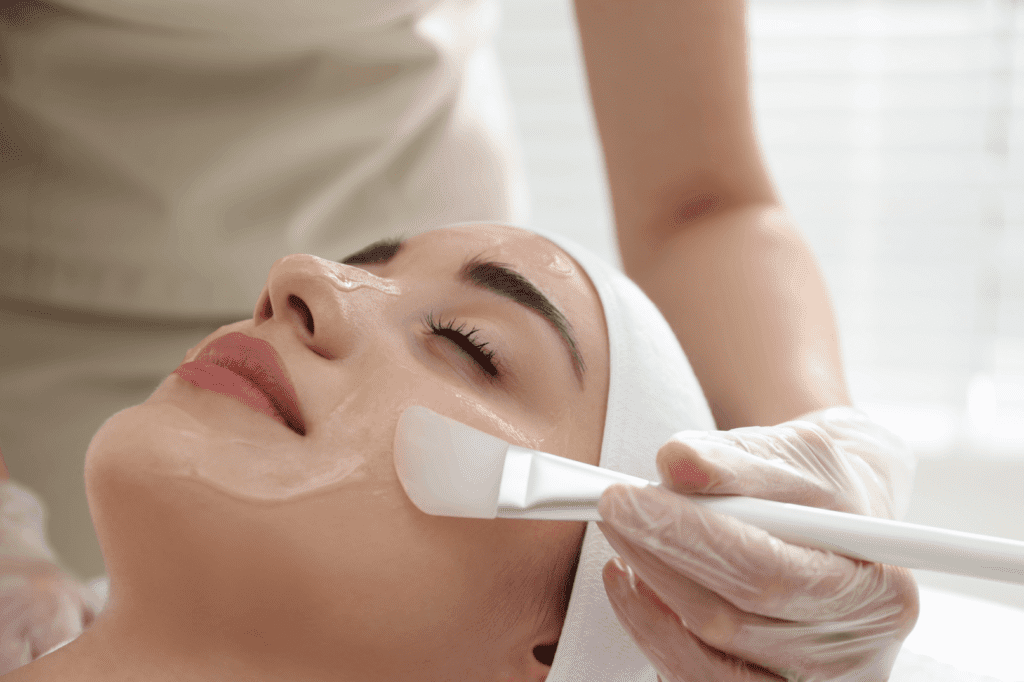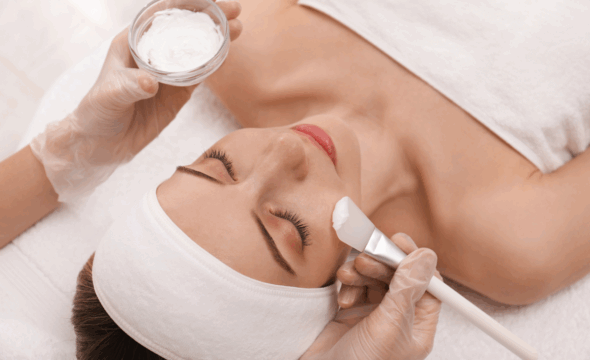Chemical Peels for Hyperpigmentation: What Works and Why
Chemical peels have become a go-to treatment for people struggling with stubborn dark spots and uneven skin tone. Whether it’s lingering acne marks, melasma patches, or sun-induced discoloration, many seek out a chemical peel for hyperpigmentation as a solution to achieve clearer, brighter skin. In this guide, we’ll explore how chemical peels work, their benefits for dark spots, the different types of peels available, and why they’re often considered one of the best peels for hyperpigmentation concerns.

Understanding Hyperpigmentation and Dark Spots
Hyperpigmentation is a common skin condition characterized by areas of the skin that become darker than the surrounding skin. This darkening happens due to an excess production of melanin. The causes of hyperpigmentation are varied. Sun exposure is a major culprit. Over time, UV rays trigger melanin production, leading to freckling or sun spots on areas like the face and hands. Hormonal changes can cause a form of hyperpigmentation called melasma, and certain medications or genetic factors can play a role as well. Additionally, any skin inflammation or injury can leave behind dark patches as it heals. These post-acne marks are not true scars but can persist for months, making the complexion look uneven.
It’s important to distinguish between dark spots and scar removal in this context. True scars are different from flat dark marks. Hyperpigmentation refers to flat discoloration, whereas scars involve a change in skin texture. Many people casually refer to dark spots as “acne scars,” but they are actually pigmentation changes rather than deep scars. This is good news, because pigment problems are generally easier to improve. The skin naturally renews itself over time, and these marks can fade; however, it may take many months or even years for them to lighten on their own. That’s where targeted treatments for post-acne marks come in, and chemical peels are among the most effective options to speed up the process.
What Is a Chemical Peel and How Does It Work?
A chemical peel is a face peel for dark spots that involves applying a chemical solution to the skin to exfoliate it deeply. The peel solution dissolves or “unglues” the bonds between dull, dead cells on the skin’s surface, causing those outer pigmented layers to shed away faster than they normally would. This reveals the fresher, newer skin underneath. As the treated skin peels off over the days following the procedure, you’re left with skin that often appears smoother, clearer, and more evenly toned. Chemical peels can improve a range of skin concerns. They help reduce fine lines, mild scars, and, importantly, uneven skin coloring and spots. A skin peel for dark spots accelerates your skin’s natural turnover. By sloughing off the damaged top layers where excess melanin is stored, peels gradually lighten hyperpigmentation, allowing healthier skin to emerge.
Chemical peels come in different strengths or “depths” – superficial, medium, and deep – which determine how many layers of skin are removed. For a typical chemical peel for dark spots, usually a superficial or medium peel is used. These are effective at addressing pigmentation in the upper to mid layers of the skin. Superficial peels utilize milder acids and only penetrate the outermost layer of the skin (epidermis), helping with surface-level discoloration and providing the skin with a brighter glow, accompanied by minimal downtime. Medium peels penetrate a bit deeper into the upper dermis, tackling more pronounced pigmentation and even some light acne scars or wrinkles, although they involve a few days of peeling and recovery.
It’s worth noting that you might not see complete results after just one peel, especially if using gentler superficial peels. Often, a chemical peel for hyperpigmentation is done as a series of treatments spaced a few weeks apart to achieve the desired improvement gradually. Each session incrementally exfoliates pigmented skin cells, and over multiple sessions, you’ll notice dark spots fading and a more uniform complexion developing.
Benefits of Chemical Peels for Dark Spots and Beyond
Chemical peels are popular not only because they can lighten pigmentation, but also because they deliver a range of other skin improvements. Some of the key benefits of chemical peels include:
- Fading Dark Spots and Pigmentation: Peels are excellent for targeting areas of excess melanin. They effectively break up excess pigment in the top layers of skin, helping to lighten sun spots, age spots, melasma patches, and post-acne marks. They specifically address the uneven tone by lifting away those darker cells.
- Smoother Skin Texture: By removing the build-up of dead skin, peels reveal a softer, smoother skin surface. Fine lines and rough patches are lessened.
- Acne Improvement: Some chemical peels can help clear out clogged pores and reduce acne breakouts. They exfoliate inside the pores and have anti-inflammatory effects, so they can improve active acne and help prevent future pimples. This dual-action formula means fewer new blemishes and fewer dark marks left behind.
- Collagen Stimulation: Medium-depth peels create a controlled wound in the skin, which can trigger the skin’s healing response and boost collagen production. Over multiple treatments, this can mildly improve the appearance of shallow acne scars or fine wrinkles as new collagen plumps up the skin.
A properly chosen hyperpigmentation peel not only makes your skin tone more even, but also gives you an overall fresher, rejuvenated look. The exfoliation from peels leads to a smoother texture and tone and noticeable lightening of dark spots on the skin.

Types of Chemical Peels for Hyperpigmentation
Aside from depth, the choice of chemical agent in a peel can be important, especially for treating pigmentation. Here are a few common peel ingredients and their roles in treating dark spots:
- Glycolic Acid (AHA): Derived from sugar cane, glycolic acid is one of the most popular peel acids. It has a small molecular size, allowing it to penetrate effectively. Glycolic acid peels are excellent for exfoliating the surface and fading uneven pigmentation. They are considered among the best chemical peels for dark spots in many cases because they’re effective yet typically well-tolerated. Glycolic peels are suitable for those with normal to oily skin; concentrations can range from 20–50% in professional settings for a series of treatments. We often see significant glycolic acid peel results after a few sessions.
- Lactic Acid (AHA): Lactic acid, derived from milk, is a gentler exfoliant with a larger molecule. It’s great for beginners or those with sensitive skin. Lactic acid peels help brighten the skin and lighten mild dark spots, while also possessing hydrating properties. If you have dry or sensitive skin with some uneven tone, lactic acid might be the best skin peel for dark spots in your case because of its milder nature.
- Salicylic Acid (BHA): A beta-hydroxy acid, salicylic acid is oil-soluble and particularly good for acne-prone skin. Salicylic peels penetrate into pores to clear out sebum and reduce breakouts. While primarily used for treating acne, they do aid in fading the post-acne dark marks over time by exfoliating the pigmented upper layers. A salicylic chemical peel for dark spots is often recommended for individuals with a combination of active acne and hyperpigmentation, as it effectively addresses both conditions.
- Mandelic Acid (AHA): Mandelic acid, from almonds, is another gentle acid known for being safe on darker skin tones. It penetrates more slowly, reducing the risk of irritation and post-peel hyperpigmentation. Mandelic peels are helpful in treating hyperpigmentation in skin of color or for individuals who need a gradual approach. They can lighten pigment while minimizing the chances of inflammation.
- Trichloroacetic Acid (TCA): This is a stronger acid used for medium peels at concentrations like 15–35%. A TCA peel is often the answer for more stubborn issues or for dark spot and scar removal when there are also textural issues. TCA can reach deeper pigment than glycolic can, so it’s effective for more tenacious discoloration or melasma that hasn’t responded to lighter peels. It must be used carefully, especially on darker skin, to avoid complications, but in experienced hands, a TCA peel can significantly rejuvenate the skin’s appearance.
In practice, dermatologists may combine ingredients to treat hyperpigmentation. The best chemical peel for dark spots really depends on the individual’s skin type and the nature of their pigmentation.
Chemical Peels for Post-Acne Marks and Scars
If you’re wondering how to lighten pimple scars, chemical peels are one of the most effective professional treatments available. After an acne breakout heals, it’s very common to be left with flat brown or red spots. This is called post-inflammatory hyperpigmentation (PIH). These marks can take a long time to fade on their own, especially in deeper skin tones where melanin activity is higher. Many over-the-counter creams and home remedies offer only modest improvement.
Chemical peels are considered an excellent treatment for post-acne marks because they specifically target the pigmented cells. During a peel, the acids remove the layers of skin that contain excess melanin deposited as a result of acne inflammation. As the skin sheds and regenerates, the new skin typically has a more even color. A series of light peels at 2-4 week intervals can gradually fade PIH from acne. This approach can significantly reduce those brown spots and get you closer to your natural skin tone much faster than waiting it out.
Can a Chemical Peel Help Dark Circles Under the Eyes?
Dark under-eye circles are a challenging issue because they can be caused by various factors – including genetics, thin skin that reveals blood vessels, hollowness, or actual pigmentation. If your dark circles are due to pigmentation, then a chemical peel for dark circles may provide some improvement. The skin under the eyes is delicate, so only mild solutions are applied, often at longer intervals, to avoid irritation.
A chemical peel will not help dark circles caused by visible blood vessels or fat loss, but if you have brownish rings under your eyes due to hyperpigmentation, peeling can lighten them. For example, a series of light peels can lift away sun-induced pigmentation or slight melanin deposits under the eyes. It’s the same mechanism as treating dark spots elsewhere: remove the pigmented cells, and encourage new, evenly pigmented skin to come in.
Professional Treatment, Costs, and “Med Spa” Considerations
When planning for pigmentation correction, factor in that you’ll likely need a series of peels for the best results. Many clinics offer package pricing for multiple sessions. It’s also worth noting that while the cost of chemical peels is a factor, choosing a qualified provider is more important than hunting for the cheapest deal. A poorly done peel can end up costing you more in the long run if complications arise.
Med spa services often include chemical peels as part of their offerings, and a good med spa with experienced practitioners can be a great place to maintain your skin. These services sometimes bundle peels with post-peel skincare or follow-ups, which adds value. When you visit a med spa for skin rejuvenation, ask questions about the qualifications of the person doing the peel, what type of peel they recommend for you, and what results you can realistically expect. A trustworthy provider will set clear expectations. They’ll tell you approximately how many sessions it might take to lighten your particular dark spots and what maintenance you should continue with. Remember that chemical peels are one tool among many. They work wonderfully for many cases of hyperpigmentation, but severe cases might also benefit from combination therapy. A dermatologist can guide you on a comprehensive plan.

Achieving that luminous, even-toned skin often requires a combination of patience, professional guidance, and the right treatments. A chemical peel for sun spots happens to tick all those boxes by offering a scientifically-backed method to resurface and renew your skin. With proper care, the results of a series of peels can last long-term. You’ll enjoy not just the fading of unwanted spots, but also the confidence that comes with clearer, rejuvenated skin. And that is ultimately why chemical peels continue to be a cornerstone procedure in dark spot and scar removal regimens: they work, and they work on multiple levels, revealing the smooth and glowing complexion that lies beneath.
Sources:
- Cleveland Clinic – Chemical Peels: Types of Peels, Conditions Treated, What to Expect
- Healthline – What’s the Best Chemical Peel for Acne Scars? It Depends
- American Society for Dermatologic Surgery – Chemical Peels (Uses and Types)
- Mayo Clinic – Chemical Peel (Risks and what it’s used for)?







